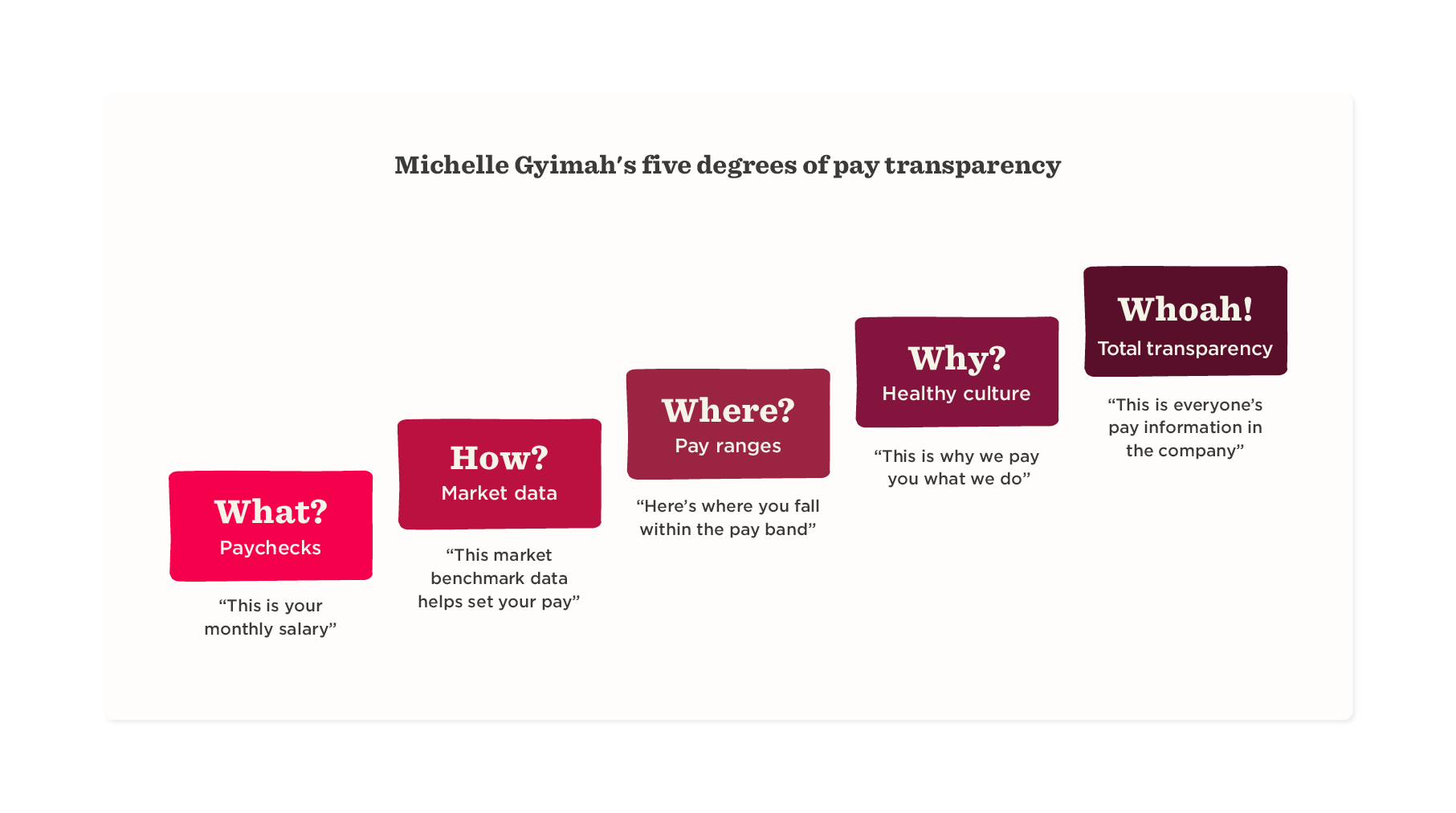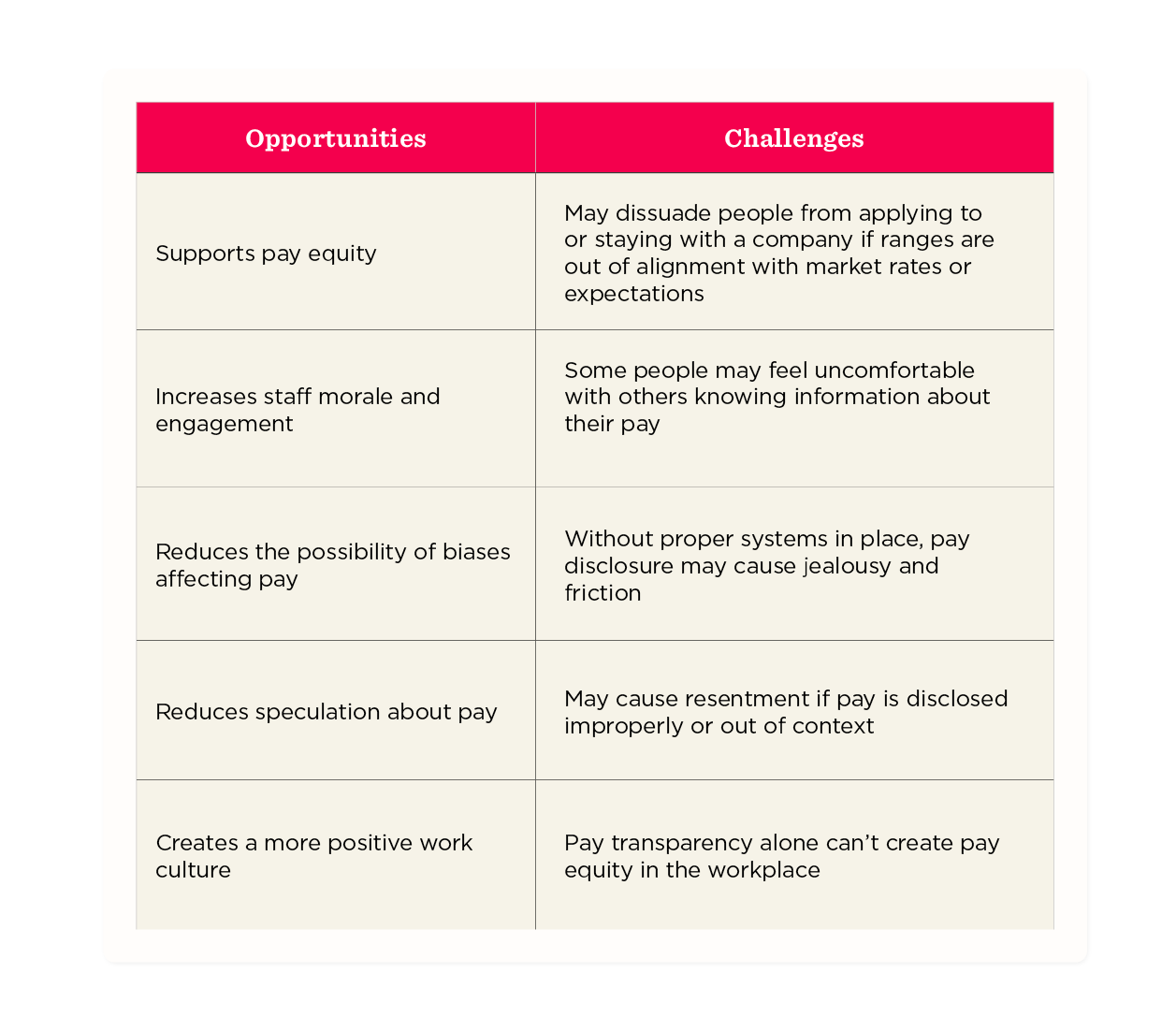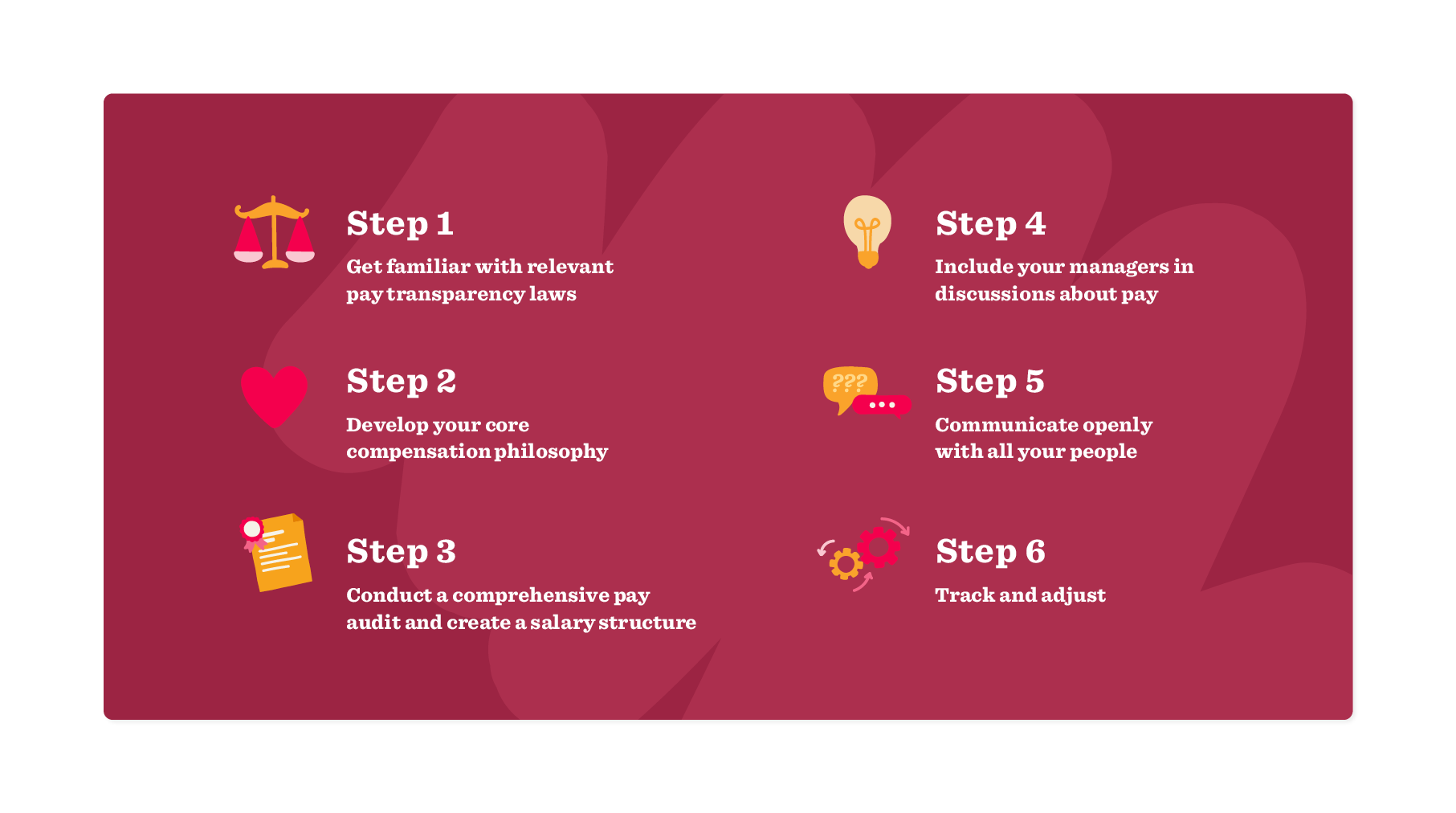Pay transparency for the modern world of work
In the modern world of work, having a fair and equitable organizational culture is more important than ever—and committing to pay transparency is fundamental to building a fair workplace. Employees want to know you’re working to eliminate pay disparities in gender, ethnicity, and age. They also want to know how their compensation measures up to those in comparable roles with similar experience levels. Being transparent about your approach to pay decision-making is a critical step to creating trust with your people.
Although businesses traditionally shy away from disclosing any compensation information, the growing demands for pay transparency from the workforce—not to mention new compliance requirements in countries around the world—require companies to think differently. But embracing pay transparency is about so much more than just maintaining compliance and answering requests from candidates and employees: It’s the foundation for a people-first company culture and pay philosophy.
Becoming more transparent about pay in pursuit of fairness and equity can be complex, especially when the degree of transparency that’s right for your company is often a moving target that evolves with the market.
No matter what, it always involves significant change and a solid change management strategy with clearly defined goals and an understanding of the correct approach for your organization. Providing your team with the resources required to lay the foundations of a robust and agile pay transparency policy tailored to your unique and evolving business needs is critical.
This guide will help you define what pay transparency is and identify the degree of transparency that’s right for your organization. We’ll explore how to develop new manager communication and enablement programs that improve awareness and fluency around compensation topics. Then, we’ll provide you with the framework you need to create policies that ensure compensation decisions are consistent and equitable.

What is pay transparency?
Pay transparency is the practice of openly sharing compensation information with current and prospective employees in the pursuit of pay equity. Pay transparency is also one strategy organizations can use to improve communication, address pay inequities, and build trust in the workplace.
You can take many approaches to pay transparency, but it’s important to know that it’s not an all-or-nothing proposition. There are many approaches an organization can take to being open about pay. It’s important to acknowledge that pay transparency can look different for every organization, depending on company strategy and local regulatory requirements.
For some, the degree of pay transparency can mean advertising salaries (or salary ranges) in job descriptions. For others, it can mean completely breaking the taboo against talking openly about salaries with co-workers and encouraging conversations about pay between colleagues. Pay transparency isn’t something static: It’s an ever-changing continuum.
Laying the groundwork for your transparency strategy is essential to determining where your organization will sit on the range. No matter what your strategy ends up being, it’s critical to provide your managers and people leaders with training to ensure fluency in your approach. This will help ensure they can effectively navigate the tough conversations with team members that will arise.
To keep things simple, the following categories proposed by pay gap analyst Michelle Gyimah explain five different degrees of pay transparency to consider for your business:
- What: Letting team members know their monthly salaries
- How: Openly share external salary benchmarking data with your people so they can compare their pay to current market rates
- Where: A thorough compensation plan that includes a breakdown of salary, compensation benefits, and a clear pay range for each member of the team
- Why: Create clear processes for calculating pay, and train managers to communicate about pay regularly
- Whoa: A completely open pay system, where the whole organization can access information about everyone else’s salary or salary range
Of course, the degree of pay transparency that’s right for your organization will depend on what’s best for your people and the business. But one thing is for sure: Pay transparency, fairness, and equity are critical to the success of modern organizations.

Why is pay transparency important?
Pay transparency policies are fundamental to demonstrating that your company is committed to addressing the gender pay gap and eliminating pay inequality.
The first step to building a successful pay transparency policy that supports fairness and equity in the workplace is to ask the right questions:
- Where does our company currently reside on the pay transparency continuum, and where is it best for us to land moving forward?
- How can we leverage our current talent strategies and company culture to create a robust and equitable pay philosophy?
- What does the market data say? How can we use it to calculate and implement consistent salary ranges for each job in our organization?
- Do our salary ranges need to be adjusted to keep up with market benchmarks?
- Do people’s salaries fall outside of or inside the lower end of our salary bands, and how much do we need to adjust them to bring them in line?
- Do we currently have any unidentified discriminatory pay practices in place?
- How familiar with fair and equitable pay practices are our people managers?
- How can we promote trust and openness about pay across our organization?
Ultimately, it’s up to company leadership, spearheaded by HR, to decide how open you want to be. There’s no set formula to follow.
<<Use these templates to conduct your own salary analysis>>
The evolution of pay transparency
People’s views on and approaches to pay transparency are evolving. Not too long ago, talking openly about pay and even broaching the subject of compensation transparency was considered completely taboo. Companies openly discouraged their people from discussing their salaries with each other. Now, pay secrecy policies prohibiting people from talking about what they earn may infringe on people’s legal right to discuss their wages.
In addition to legislation, people’s demand for transparency in pay is high, and promoting more openness around pay can work to the advantage of modern companies: Wage transparency and posting salary ranges on job ads saves time and helps attract the right candidates with realistic expectations that align with what the company needs. It also serves as a pillar of healthy company culture and helps support trust between your people and the organization, spurring higher levels of loyalty, engagement, and feelings of appreciation and value.
Today’s push for more pay transparency lies at the heart of combatting pay inequality. It often takes the form of people self-reporting their wages, companies including salary ranges in job ads, and people speaking more openly about their pay with their colleagues. Meeting the modern professional’s expectations is important for employers, but it’s also important to make it clear to your people that not everyone in the same role will receive the same compensation.

One of the biggest challenges HR and line managers face is explaining the nuances of pay transparency to their people. Many professionals understand “pay transparency” to mean that a company is completely open about everyone’s compensation. They may also believe that everyone in the same or similar roles should receive the same compensation and benefits packages. In reality, this is not the case.
Paying people in the same or similar roles competitively means that their salaries fall within set pay bands. Some people will fall at the lower end of the range and some will fall at the higher end. Where an individual’s compensation sits within the salary range depends on their particular level of experience, performance over time, and other factors, including location, remote vs. on-site mandates, etc.
As a growing percentage of today’s workforce commits to fighting pay inequality and championing pay parity, it is no surprise that pay transparency laws are also on the rise worldwide.
Pay transparency laws around the world
While legislation differs between countries and even by state within the United States, every pay transparency law aims to close wage gaps.

Laws surrounding pay transparency are constantly changing, and complying with each of them can be a huge challenge, especially if your company has sites at different locations around the world. Building transparency around compensation into your core company philosophy can help ease the pain of keeping up with evolving and emerging laws.
The information on pay transparency laws below is here to give you an overview of legislation you may need to be aware of, depending on where your company operates. To ensure your organization maintains compliance with pay transparency laws in the jurisdictions in which it operates, always consult a local legal advisor.
United States pay transparency laws
In the United States, the National Labor Relations Act passed in 1935, defends the rights of professionals working in the private sector to engage in discussions about pay and help promote fair and equitable compensation practices in the workplace. Similarly, the Office of Federal Contractor Compliance Programs (OFCCP) protects public sector workers.
To date, eight US states currently have pay transparency laws. In addition, several cities, including New York City, NY, Cincinnati, OH, and Jersey City, NJ, have municipal legislation. As of June 2023, “more than 25% of U.S. workers are covered under pay transparency laws,” and with more states and municipalities introducing new legislation, “that could soon be near 50%.”
The specifics of the laws vary in each jurisdiction but can obligate employers to disclose salary ranges:
- In their job postings
- When someone asks
- To job applicants at specific stages of the hiring process
United Kingdom pay transparency laws
Similar to the US, national legislation in the UK protects private and public sector employees from discrimination in pay under The Equality Act 2010 (Gender Pay Gap Information) Regulations 2017, which applies to organizations with a workforce of 250 or more in the private and voluntary sectors. In parallel, The Equality Act 2010 (Specific Duties and Public Authorities) Regulations 2017, applies to public organizations with a workforce of 250 or more employees.
Both laws compel organizations to publicly report on gender-based pay and bonuses and publish the information on their company websites.
European Union pay transparency laws
On April 24, 2023, the EU adopted a new directive aiming to eliminate pay discrimination and narrow the gender pay gap in member countries. The EU Pay Transparency Directive requires member states to pass national pay transparency laws within the next three years. Laws passed must stipulate that companies provide:
- Access to information. Organizations must disclose pay ranges to candidates. Likewise, they must disclose average pay levels and pay criteria to current employees. Employers are also prohibited from requesting salary histories from candidates.
- Reporting. Organizations with more than 250 employees must submit an annual report on their gender pay gap data to the appropriate national authority. Companies with only 100-250 employees will only be required to report their data every three years. If a report shows a pay gap of over 5 percent, the company will be required to perform a joint pay assessment in conjunction with employee representatives.
- Access to justice. If a report shows that people have experienced pay discrimination, companies will be obliged to compensate them.
- Broadening the scope. The directive now covers intersectional discrimination and includes ethnicity, sexuality, and disability in the applicable scope of the law, along with gender.
Pay transparency laws in Australia
Australia’s Fair Work Legislation Amendment (Secure Jobs, Better Pay) Act 2022 contains various work-related regulations.
The Act bans pay secrecy clauses in employment contracts and makes it illegal to prohibit people from discussing and disclosing their pay with each other. The Act also bans posting pay ranges below the minimum wage.
Additionally, Australia passed the Workplace Gender Equality Amendment (Closing the Gender Pay Gap) Bill (WGEA) that requires companies with over 100 employees to publish their gender pay metrics and report them to their boards and governing shareholders. Companies with more than 500 employees will also be required to report their strategies on various gender equality indicators to the government, including the gender composition of their workforce, the gender pay gap ratio, and sexual harassment.
How pay transparency can boost your business
Beyond maintaining compliance, embracing pay transparency can help today’s businesses succeed and build a culture of trust. But there’s more to it than that.
Embracing pay transparency is an untapped opportunity for modern businesses and is fundamental to staying competitive in today’s tight labor market. Creating cultures of fairness and equity is one of the keys to attracting and retaining top talent, driving productivity and engagement, and leading the future of work.

It promotes trust
Today’s professionals expect their employers to be open, honest, and equitable about compensation from day one. Being transparent about pay meets this demand and shows candidates and current team members that your organization takes advocating for healthy communication around compensation practices seriously.
Achieving pay transparency goals can start small and doesn’t have to mean making your entire workforce’s salary and benefits information public. Simply encouraging members of your leadership team to have open conversations about pay is a huge step forward and paves the way for more transparency with more members of your team over time.
These conversations are the foundation of building trust, eliminating pay secrecy practices, and nipping rumors in the bud (and any resentment that can grow out of them). Transparency about compensation also encourages open conversations about other topics in the workplace, fosters a sense of community, and supports collaboration and a healthy work environment—all while building a culture of trust.
It keeps you competitive
The labor market has never been tighter, and staying competitive is critical if you want to get ahead and stay ahead. Committing to pay transparency is one way you can demonstrate that you’re serious about fair treatment and pay in the workforce, that you value people’s input, and that there’s no room for bias and discrimination in your work environment.
It helps attract and retain top talent
Modern professionals value pay parity and fairness in the workplace. People have more access to compensation benchmarking data than ever through platforms like Indeed and Glassdoor, professional networks that publish salary surveys, unions, or people’s newfound openness to sharing their personal pay information.
They’re more likely to accept offers and remain with organizations that offer transparency and competitive compensation and benefits. Ultimately, being transparent about your pay practices can act as a powerful incentive to keep your best people with the company and can be one of the best ways to boost retention. It also serves as an effective recruitment tool that can reduce costs while broadening your pool of talented, diverse, and qualified applicants.
It drives productivity and engagement
Being open and transparent about pay motivates people to excel in their roles and propel business success, effectively lowering overhead costs (think recruitment budgets, etc.). This is especially true when your people can see how closely their compensation is tied to their performance. Providing your people with visibility into the link between performance and pay also shows them that their work is valued by the organization and drives engagement and productivity—boosting your bottom line.
<<Learn how Bob can help you achieve your pay transparency goals>>
Pay transparency implementation challenges and solutions
There’s a growing buzz around pay transparency around the world right now—and with good reason. But let’s be honest: Implementing pay transparency practices and getting them right is hard.
According to a survey by Willis Towers Watson (WTW), 31 percent of employers said they aren’t ready for transparency, and 46 percent stated they’re “putting off disclosing pay.” Meanwhile, 92 percent of today’s professionals say they support pay transparency laws.
Here are some of the opportunities and challenges to consider when implementing pay transparency.
While pay transparency might seem like a no-brainer, without a cohesive, clearly communicated pay transparency policy that you’ve enabled your managers to speak to, even the best intentions can unravel into ambiguity, miscommunication, and (at worst) tensions in the workplace.

There are many challenges when it comes to implementing transparency. Solving these four is key to helping you lay the foundations of a competitive compensation policy that’s transparent, fair, and equitable for all your people across every one of your global sites.
1. Build (and stand by) a core compensation philosophy
The first step to getting pay transparency right at your organization is ensuring you have a core compensation philosophy that guides how everyone approaches pay decisions. The second step is ensuring you’ve communicated it well to your managers.
A consistent philosophy about pay ensures that no one at your company is forced to make decisions around compensation in a vacuum. It’s an essential tool that decision-makers, like recruiters, hiring managers, and comp and ben specialists, can rely on when making decisions around compensation during the hiring process.
Your core compensation philosophy is also there for you to lean on when making decisions around employee lifecycle events, like promotions, raises, and regular compensation cycles. If you’ve never built one before, it’s always a good idea to start by aligning the core tenets of your philosophy with any compliance and legal requirements—and ensuring every decision is made based on reliable, HR-reported data.

2. Ensure access to HR-reported market data
Making decisions in the dark is never a good idea, especially when it comes to pay. Ensuring your company and the relevant decision-makers have access to official, HR-reported market data is critical for benchmarking and confirming your compensation practices are fair and competitive. Having access to salary benchmarking data is also the best way to avoid making decisions based on gut feelings and guesswork, one-off candidate and employee feedback responses, and free online (and often unreliable) compensation data sources.
3. Gain visibility into your internal compensation data
HR-reported market data is key to implementing a successful pay transparency program. Your internal people analytics are just as important.
Visibility into internal compensation data allows your HR and compensation and benefits teams to conduct pay gap analyses on similar jobs and roles within the company—and communicate accurate information to your managers.
Company-specific compensation analytics help you identify any pay gaps and inconsistencies, enabling you to create a data-driven action plan that rectifies them on a rolling basis. Most importantly, internal data provides you with a better understanding of how prepared you are for launching a successful pay transparency program.
4. Price job roles, not candidates and current team members
Another key to achieving your pay transparency and equity goals is pricing job roles, not people. Job pricing—or setting salary ranges for roles—is essential to keeping compensation equitable.
The traditional practice of pricing candidates vs. roles naturally encourages unfair pay practices and pay secrecy. It relies on how much individual candidates request during an interview or on a hiring manager’s feelings about particular professionals, the value they’ll bring to the company, and their price points.
Pricing job roles, on the other hand, matches job descriptions to survey data and groups of positions (e.g., specialists, managers, etc.), helping a company avoid bias against (or for) specific candidates. Job pricing sets a definitive, predetermined pay range for all roles and ensures that any individual hired for a role receives a salary that falls within the set salary band, keeping compensation equitable and fair across the board.
How to effectively implement a successful pay transparency policy
Now that we’ve talked about the challenges and some of the solutions, it’s time to dig into how to embrace pay transparency as the untapped opportunity it is.
Follow these six steps to develop a consistent pay transparency framework that supports taking a proactive stance for equity and inclusion in pay.

1. Get familiar with relevant pay transparency laws
Every country has its own unique legislation pertaining to pay transparency. In the US, it can be even trickier, with states and even cities passing geo-specific laws. Speak to your legal counsel to understand the minutia of the legislation in the geographies in which you operate to ensure compliance. Then, use it as the foundation of your core compensation philosophy.
2. Develop your core compensation philosophy
Your core compensation philosophy sets the tone for your pay transparency policy, establishes the framework behind why you’re deciding on certain structures and compensation policies, and ultimately determines the right level of transparency for your organization. At this stage, it’s crucial to bear in mind that pay transparency isn’t something you can just turn on and off like a light switch. It’s a continuum.
Ask yourself and other decision-makers questions like these when developing your compensation philosophy:
- How open does it make sense for your organization to be about compensation?
- Do you want to be fully open about all your people’s compensation information? Full transparency means everyone in your organization, from every individual contributor all the way up to the CEO, knows everyone else’s compensation information.
- Should full visibility into compensation information be limited to only HR and finance professionals? Or, should managers also have full visibility into their teams’ information?
<<Use these templates to conduct your own salary analysis>>
Before you start, consider using a compensation analysis template to help you determine where you currently stand and what changes you need to make to align with your core compensation philosophy. Whether you decide to be fully transparent with everyone or limit full visibility to people in certain key roles, any step away from pay secrecy is a step up toward creating a healthy culture rooted in the principles of equitable pay practices.
3. Conduct a comprehensive pay audit and create a salary structure
To understand how well you’re doing to combat pay gaps and inequities, conduct a comprehensive pay equity audit.
Draw on compensation benchmarking data—internal and external—and conduct salary surveys to provide you with as much insight into where, if any, pay gaps exist, how wide they are, and what departments or roles have the most. Pay audits are also a great starting point for job pricing and creating an equitable salary structure for your company.
<<Download and print the pay equity template to run a fair and equitable process>>
Once you get a sense of the internal pay gaps and inconsistencies with HR-reported market data, you’ll have the salary benchmarks and other information you need to define competitive and internally equitable pay for every position and role across your company.
Make it easier for yourself by grouping pay bands into a company-wide structure, determining where team members fall within it, and then identifying the gaps and the cost of adjusting them to competitive market rates.
4. Include your managers in discussions about pay
Transparency depends on keeping your managers in the loop about any compensation decisions. After all, your managers are the first ones people speak to when they have questions about their compensation. They stand at the front line when it comes to making decisions (or delivering news) about pay.
This is why it’s important to educate managers about your compensation philosophy and provide them with access to the compensation and benefits data relevant to their team. To ensure they have full fluency around compensation topics and can effectively respond to challenging questions from team members about pay, provide them with ongoing training on comp and benefits and communication best practices.
5. Communicate openly with all your people
Educating and communicating with all your people about your compensation philosophy is just as important as imparting that information to your managers. Give your people visibility into how you make decisions about pay, explain why those decisions make sense (and how they benefit everyone), and open up spaces for them to have in-depth conversations about career growth and pay progression.
6. Track and adjust
Now that you have a set pay philosophy and salary structure, it’s time to measure its efficacy. The market is always changing, which means keeping your pay fair and equitable is a commitment that requires continuous monitoring and adjustment.
Fall back on the data: Conduct pay audits once or twice a year, continue communicating with your people, and ensure you stay on top of the latest salary benchmarks and pay gap data available so you can adjust your policy accordingly.
Sticking to these steps and committing to pay transparency is the cornerstone of creating a culture of fairness and equity. Keep it fair and equitable to stay competitive and attract the talent that excels at powering business agility and achieving goal-crushing results.

Meet Bob
Bob’s powerful and flexible HR solution is here to help modern, global organizations get the data and tools they need to be proactive about pay transparency and build a fair and equitable company culture. With Bob, it’s easy to accurately price jobs, define pay ranges, assess gaps, make smart compensation decisions, stay on top of changing regulations, and communicate about pay with confidence—all from one platform.
Bob helps you stay compliant
- Create a salary structure: Tap into Bob’s Compensation Benchmarking Powered by Mercer and use our Compensation module to build a comprehensive salary structure for your entire organization. Group similar jobs together and create salary ranges and bands to help with workforce and budget planning, compensation management, and reporting.
- Continuous monitoring: Bob’s Analytics makes it easy to stay on top of all your data with out-of-the-box dashboards and the ability to customize your own. You can also create custom reports to track and monitor the compensation and pay equity metrics that matter most to your organization.
Recommended For Further Reading
Bob helps you define your pay philosophy
- Conduct a comprehensive pay audit: HR and managers can easily identify pay gaps by gender, ethnicity, age, sexual orientation, disability, and other protected classes. Dig even deeper with Bob’s Compensation Benchmarking Powered by Mercer to quickly and accurately price jobs according to market rates and define geo-specific pay ranges to ensure your offerings are competitive to attract top talent in every market.
- Get buy-in for adjustments: Bob’s Workforce Planning module helps you quickly and easily understand what needs to be adjusted at your company and the cost of those adjustments.
Bob helps you create a transparent culture
- Get managers involved: Provide managers with the ability to answer tough questions from your people about compensation and pay fairness all year round. Bob’s Compensation module provides managers with access to the critical compensation data they need to make fair and equitable decisions about pay for their teams, like current salary and compensation history, position-in-range, performance, tenure, eligibility for increase, and more—all in one place on an ongoing basis.
- Ensure fair performance evaluations: Bob’s Talent module gives your managers side-by-side views into peer reviews and employee self-reviews, goal attainment, growth plans, activities and check-ins, and other information to help drive fair and unbiased performance evaluations. View talent and compensation data simultaneously to improve data-driven decisions about pay, and easily audit the entire process, ensuring pay-for-performance policies are applied equitably.
- Openly communicate about pay: HR leaders can model company-wide scenarios to close gaps, and easily share the information with colleagues in Finance and members of the C-suite and board for review and approval.
<<Learn more about how Bob helps you achieve your pay transparency goals>>

